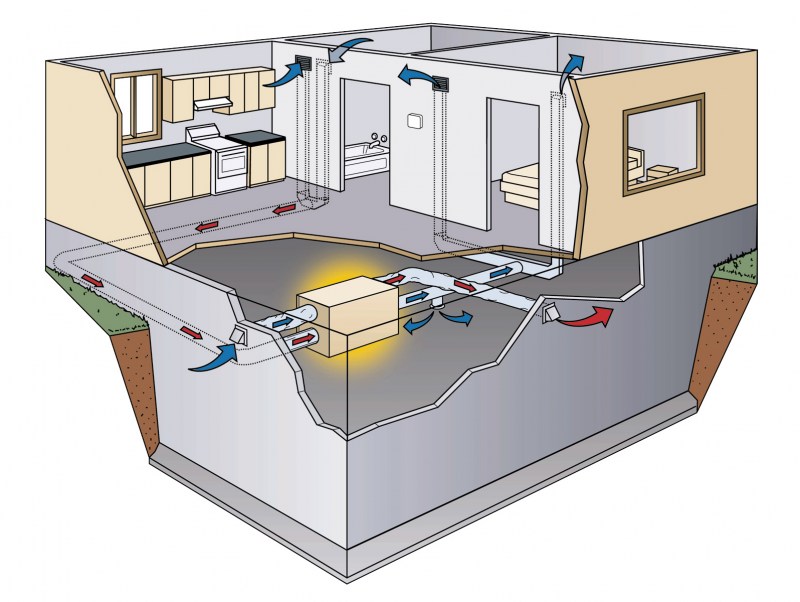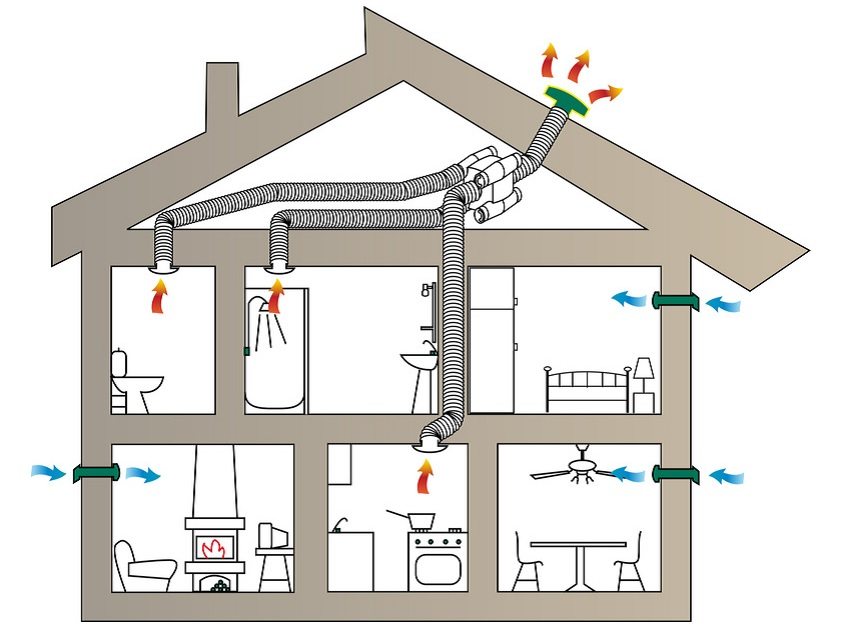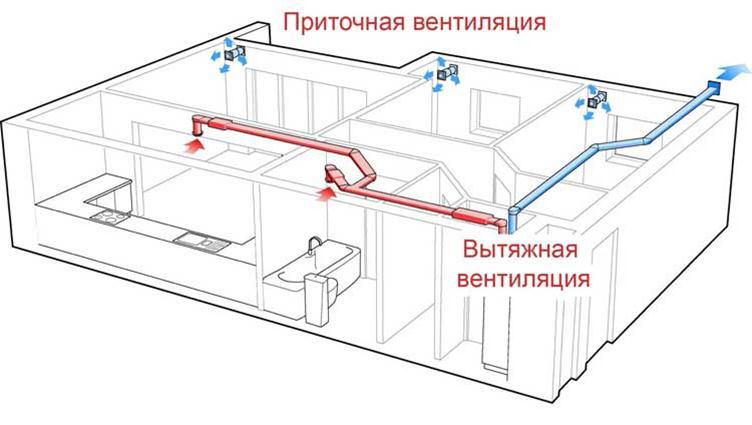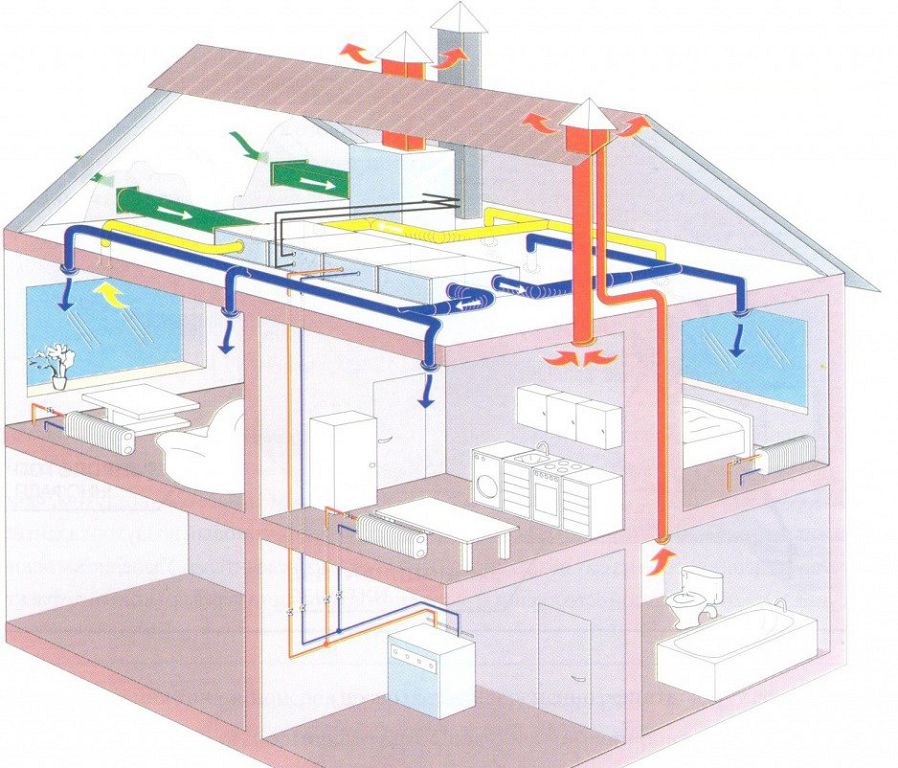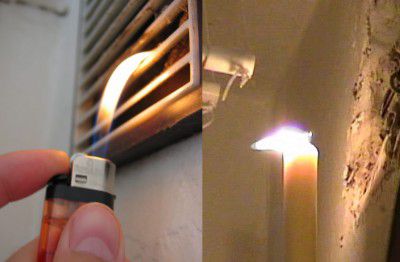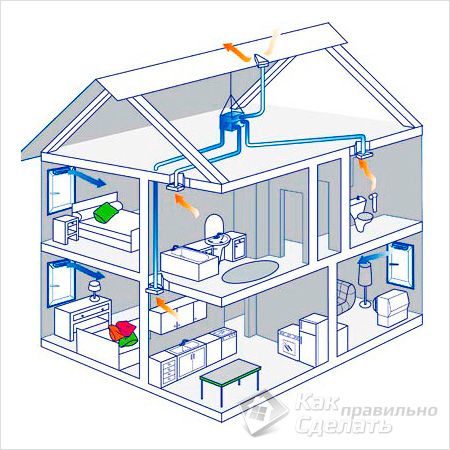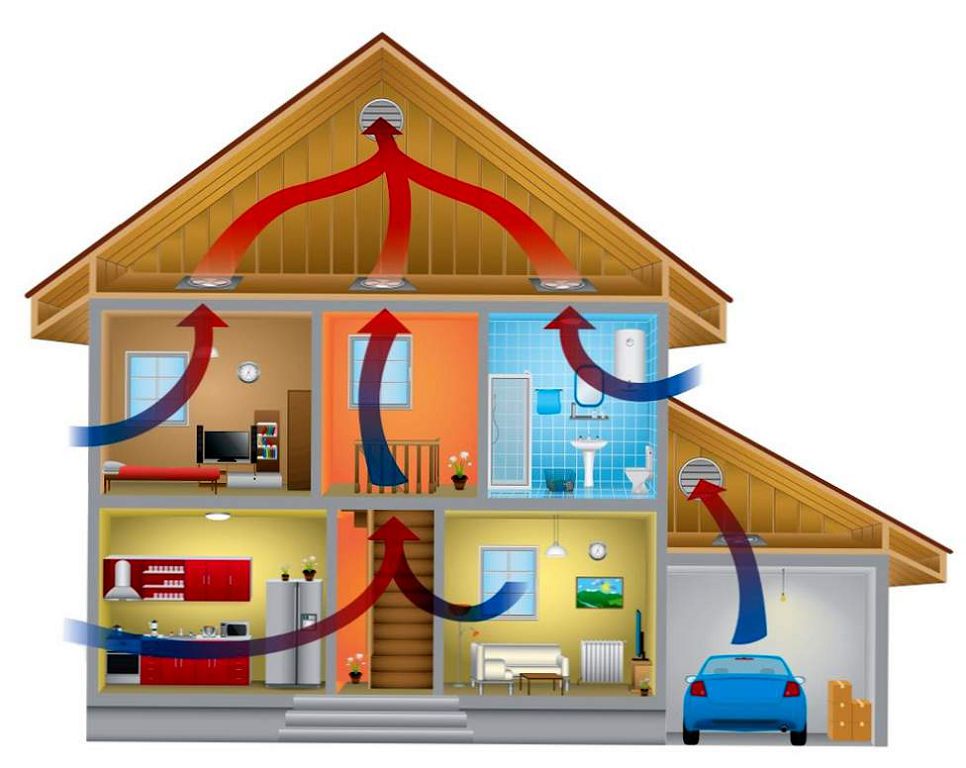- The need for ventilation in the basement
- Air vents for basement ventilation
- Supply and exhaust ventilation of the basement
- Small basement ventilation
- Forced ventilation of the basement
- Method number 1
- Method number 2
- Basement ventilation with your own hands
- Checking the performance of the basement ventilation
- How to check her work?
The need for ventilation in the basement
It does not pull from the floor with dampness, and the potatoes are stored until spring, when the ventilation in the basement of the house is done correctly. Ventilation provides an organized movement of air masses in the basement. Due to the constant exchange of air between the street and the basement, a constant temperature and humidity are established in the room. Excellent conditions are created for storing vegetables and supplies, mold and mildew do not start. If there is no air movement, it will be impossible to use the basement as a storage room. Endangered materials of the foundation and floors, suffering from constant exposure to moisture. But the main threat lurking the residents of a house with a warm unventilated basement is a fire or explosion caused by a high concentration of carbon dioxide. Gas is emitted during the operation of heating equipment, often installed in the basement. Therefore, ventilation is simply necessary in the basement of a country house.
Mold spores that inhabit damp, unvented basements are a major threat to supplies and residents. In wooden houses, fungus can cause the destruction of load-bearing beams and even the collapse of structures. Inhalation of mold spores contributes to the development of respiratory diseases, asthma and allergies. Therefore, ventilation is necessary in the basement of any residential building.
The principle of movement of air flows for ventilation of the basements of private houses in the photo-diagram.
Air vents for basement ventilation
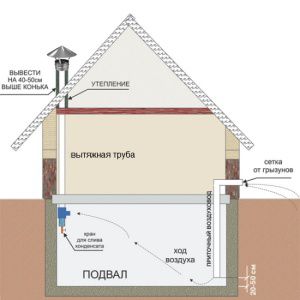
You should think about how to make basement ventilation in a private house even at the stage of laying the foundation. The simplest and cheapest option for ventilation in the basement of a house is a ventilation system or simply holes in the basement. From the inside, the vents are covered with nets from rodents and insects. In the photo there is a basement ventilation in a private house with an air system.
The efficiency of ventilation in the basement of a wooden or stone house will always depend on the strength and direction of the wind, the temperature outside.
When organizing this type of air exchange, it is important to correctly calculate the area of the vents, which is 1/400 of the basement area.
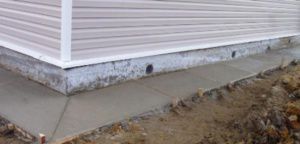
When calculating the area of the air, you should also take into account:
- depth of the foundation;
- type of soil and proximity of soil waters;
- direction of prevailing winds;
- the amount of precipitation in different periods of the year;
- differences in daily and annual temperatures.
The size of each hole is also regulated:
- diameter from 12.5 cm;
- area from 50 sq. cm.
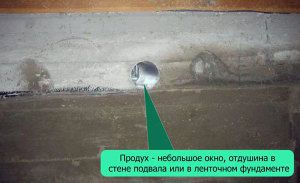
For ventilation in the basement of a residential building to work effectively, it will be enough to have a couple of holes on each side of the house.
Houses of complex configuration or located in the lowlands will have to be provided with enhanced ventilation: 2 air vents per 4 meters of the foundation.
If a foundation is arranged under the inner walls, air vents are also made in additional structures. Natural ventilation can be made controlled by installing air vents. In winter, the dampers are closed, and in summer they open completely. In bitter frosts, narrow cracks are left, since the draft is very strong and the basement will instantly cool down.
But such ventilation of the basement in a country house will not work if it is used as a storehouse for vegetables and fruits in winter. Air exchange will not be effective enough even with a large area of \ u200b \ u200bthe house. For ventilation of the basement of an apartment building, air vents are used only as an additional tool. The main one is choosing a two-pipe (supply and exhaust) ventilation system for the basement of a residential building.
Supply and exhaust ventilation of the basement
The microclimate in any basement is best maintained by the supply and exhaust system. It consists of two air ducts: one for the air intake, the other for the exhaust.
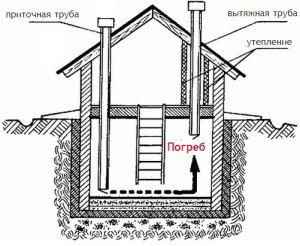
The lower end of the supply pipe is fixed 50 cm from the basement floor, and the upper one should protrude 1 meter beyond the soil level.
The lower end of the chimney is 150 cm from the basement floor, the upper end extends 50 cm beyond the roof ridge.
The temperature difference at the lower and upper ends provides traction: through the supply pipe from the street to the basement, along the exhaust pipe to the street.
Place ventilation ducts on opposite sides. If you neglect this rule, stagnant, unventilated zones will be created in the room. Air will only move along one wall. And here, too, it is necessary to equip a system of dampers that control the intensity of ventilation.
If the owner decided to do the ventilation of the basement of the house himself, as a rule, plastic pipes with a diameter of 10 - 15 mm are used. The larger the area, the wider the pipe. For an area of 40 sq. meters, it is better to take a pipe with a diameter of 12 mm.
A more laborious method of manufacturing ventilation ducts is from wooden boards. The inner surface of the ducts should be as smooth as possible, so the boards are processed with a plane. Slots will impair traction. The advantage of wooden ventilation in the basement of an apartment building is the absence of condensation on the walls.
The upper ends of the pipes are covered with umbrellas, which do not allow sediment to pass inside and are involved in adjusting the air flow rate. The shorter the supply pipe is compared to the exhaust pipe, the more powerful the flow. This property is used to adjust the intensity of traction.
The basement of apartment buildings is divided into several compartments, ventilation inflow-exhaust is mounted in each of them.
Good ventilation of the basement of a private house provides twice the air exchange per hour, that is, the entire volume of air is replaced twice in 60 minutes.
Small basement ventilation
Ventilation of a small basement of a private house works on the principle of inflow-blowout. But here the only ventilation duct made of wood, divided into two compartments, will cope. One of them serves for the inflow, the other for the exhaust.
In severe frosts, the ventilation ducts must be closed.
Forced ventilation of the basement
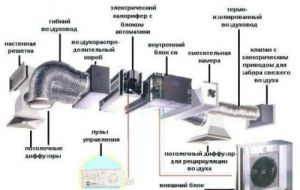
Natural ventilation may not cope with its functions in hot, windless weather, when the temperature difference is very small. If the house is located on a hillock, where the breeze almost always blows, such a system is sufficient. And in order to increase the draft, the supply channel is installed from the northern part, 2 meters from the nearest fence or wall.
Often no tricks make the air move. And then they resort to using forced ventilation in the basement of a private house.
In addition, forced draft is equipped with:
- In large basements with an area of 40 sq. meters and more. In winter, warm air flows through the chimney. When it comes into contact with a cold pipe, condensate falls out, settling on the walls and gradually freezing. During prolonged frosts, the entire lumen of the pipe may be covered with snow and ventilation in the basement of this house will stop;
- When they are going to equip a sauna, a sports hall, a games room or a workshop in the basement. Forced ventilation of such a basement in a private house will help at the same time remove unpleasant odors and provide people with fresh air.
The standard scheme of forced ventilation consists in the mechanical supply of air from the street, which is filtered, brought to the required temperature and supplied to the basement. At the same time, the exhaust air is drawn out through the exhaust ducts into the street.
To implement it, you need a lot of bulky and expensive equipment:
- ventilation ducts;
- diffusers;
- air outlets;
- air intakes;
- air flow mixing chambers;
- blowers (if the supply ventilation will serve not only the basement, but also the living quarters).
A photograph of such a basement ventilation system in a private house clearly demonstrates its complexity and monumentality.
Advantages of forced ventilation in the basement of a wooden house:
- independence from weather conditions;
- constant work in the desired mode.
Minuses:
- complex installation;
- high price.
We offer two schemes of forced ventilation in the basement of a private house, which you can implement yourself.
Method number 1
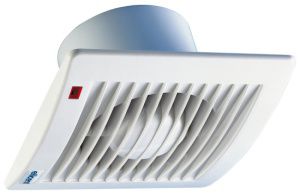
A pair of fans is required (sometimes one). It is mounted on the inner lumen of the exhaust duct to strengthen the hood. When the fan is on, the air in the basement is discharged, the deficiency is compensated for through the supply duct. If the basement area is large, a pair of fans are installed.
The second will be required for the inflow to balance it with the outflow of air. This ventilation device in the basement of a private house is very simple. The owner, who has the simplest construction skills, will be able to mount it on his own.
The entire ventilation system of the basement of a country house is controlled by one switch. When installing, it should be borne in mind that the basement floors are classified as wet rooms. Therefore, it is allowed to install only electrical equipment operating from 36 volts and equipped with safety devices. Otherwise, breakdowns to the case, short circuits and all subsequent troubles are possible.
Method number 2
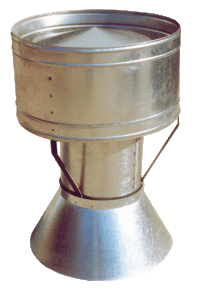
How to make non-volatile ventilation in the basement of a private house? There is such a method, forced draft is provided by the movement of the wind. The outer end of the exhaust duct ends with a special type of deflector. Approximately such structures are supplied to train carriages. When the wind hits one side of the deflector, the pressure increases in the other. Due to this effect, the thrust is increased significantly. You can also install small impellers, working on the principle of a weather vane. Rotating, they transmit the movement through the shaft system to the fan built into the ventilation duct.
Both methods allow you to change the intensity of air movement and use natural ventilation. Therefore, pipes for exhaust and inflow are placed in accordance with the rules for the installation of inflow-blowout systems. But the diameter of the pipes is chosen less than one and a half times, because the mechanical traction is quite intense.
Basement ventilation with your own hands
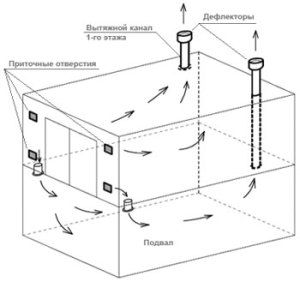
Thinking over the ventilation device in the basement of a private house, many come to mind to cut out the air vents in the basement on their own. This is the right decision if the house is small. Holes can be made neatly and beautifully by diamond drilling.
The height of the center of the holes from the surface of the earth should be at least 0.3 meters so that water does not get into the basement during showers and melting snow. The diameter of the vents is from 125 to 225 mm, depending on the basement area. From the inside, a mesh and a lattice are attached to them. You can call a specialist who will advise on ventilation in the basement of a private house and make all the calculations.
You need to start arranging supply and exhaust ventilation in the basement of a private house by drawing up a diagram. The simplest schematic drawing will serve as a serious help when calculating the length of pipes, the number of clamps. Next, you need to punch holes and channels for air ducts. The most convenient way is to dig out the foundation a little, make grooves, and then install the air ducts.The pipe is fastened with clamps to the wall. Condensation will accumulate inside the pipe, it can be drained through the tap on the water collector (sold in hardware stores).
Having figured out how to make ventilation in the basement of a private house, let's talk about suitable building materials.
Pipes made of PVC or galvanized sheet are widely used as ventilation ducts. For connections of plastic pipes, adapters and corners are sold from the same material. But with metal you will have to tinker, here you need the skills of a tinsmith. In addition, condensate, which inevitably collects on the pipe walls, will sooner or later lead to rust at the joints.
As for the above-mentioned wooden air ducts: their manufacture is laborious and is practically not used in modern construction.
Therefore, our recommendation: PVC pipes.
Checking the performance of the basement ventilation
Over time, even properly made ventilation in the basement of a private house can clog.
How to check her work?
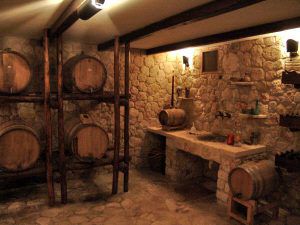
The method is simple: a piece of paper is applied to the inner end of the exhaust hole. If the traction is good, it will stick to the grill like glued. Of course, the piece of paper will behave in the same way when the fan is on.
You can install an alcohol (street) thermometer in the basement and track the temperature change. A device for changing humidity - a psychometer - does not hurt either. The place for the devices is selected near the supply channel.
The optimum temperature for a vegetable storage basement is 3-5 degrees above zero, for a gym, sauna or billiard room +17 - 21.
Basement ventilation in a private house should maintain a relative humidity of 85 - 90% for a storage room and up to 60% for a utility room.
Signs of poor ventilation in a private house:
- drops of condensation on the walls and ceiling in the basement;
- heavy air;
- unpleasant odors;
- mold appears.
The fact that the level of carbon dioxide has been exceeded is indicated by a match quickly extinguishing in the basement.
If the above alarms are found, the basement hatch and all ventilation flaps are opened for 24 hours.
With an increase in humidity of more than 90%, a box with sawdust, salt or lime (quicklime) is installed in the middle of the room. They will absorb excess moisture from the air and lower the relative humidity. The box can be used several times by drying its contents in the sun.
When mold appears, the affected surface is cleaned and treated with special solutions or whitewashed with lime. It is undesirable to use bleach. After processing, the air movement is increased for several days. The procedure is carried out annually before laying fruits for the winter.

